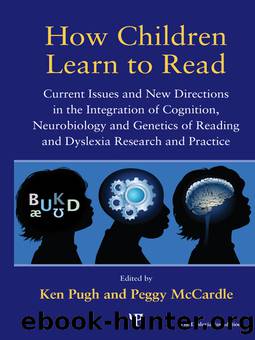How Children Learn to Read by Pugh Ken;McCardle Peggy;McCardle Peggy;

Author:Pugh, Ken;McCardle, Peggy;McCardle, Peggy; [James S. Nairne]
Language: eng
Format: epub
ISBN: 668537
Publisher: Taylor & Francis Group
A NEW HYPOTHESIS
The experiments that we have described were designed to test various hypotheses regarding the status of the phonological system in dyslexia. Overall, their findings converge toward one single conclusion: The phonological representations of people with dyslexia are normal. Of course, this conclusion cannot be considered as proven. Many aspects of the phonological representations of people with dyslexia still remain to be tested. Nevertheless, let us consider for the sake of discussion that our conclusion holds. What, then, might be the nature of the phonological deficit? If phonological representations are normal, if phonological grammar is acquired normally, then whatâs wrong with phonology?
The first important remark to make is that our results do not challenge in any way the very existence of a phonological deficit. Indeed, our own data attest that our participants with dyslexia have a phonological deficit, as measured in the traditional sense, using, for instance, spoonerisms, nonword repetition, and rapid naming tasks. So it is not time to abandon the phonological deficit hypothesis, merely to rethink its precise formulation.
A comparison of phonological tasks in which participants with dyslexia show normal as opposed to poor performance provides important clues. First, task requirements, and in particular short-term memory load, seem paramount. This is obvious in span tasks where difficulties appear as sequence length increases. It is also the case in most phonological awareness tasks, which require the subject to hold segmented phonological units in short-term memory and to have conscious access to those representations. In fact, the most difficult phonological awareness tasks for people with dyslexia turn out to be those that load most heavily on short-term memory (e.g., spoonerisms). One type of task that challenges people with dyslexia without recruiting verbal short-term memory is rapid naming. Given that they do not always have problems with single picture naming, it seems that in this case the crucial task constraint is speed (Marshall, Tang, Rosen, Ramus, & van der Lely, 2009; McCrory, 2001; Szenkovits, Ramus, & Dupoux, 2009; but see Snowling, van Wagtendonk, & Stafford, 1988; Swan & Goswami, 1997b).
In an attempt to provide a unifying explanation for those task constraints that seem to pose specific problems in dyslexia, we tentatively propose the concept of phonological access. By this, we mean all processes by which (lexical or sublexical) phonological representations are accessed for the purpose of external computations. Verbal short-term memory requires access to phonological representations for the purpose of copying them into buffers, then access to phonological buffers for retrieval (see Figure 8.1), access to input representations to copy them into output representations, and access to output representations to recycle them into input representations (i.e., the phonological loop; Baddeley, 1984; Jacquemot & Scott, 2006). Phonological awareness tasks additionally involve conscious access to phonological representations, which may place special demands on access mechanisms. And rapid naming tasks require multiple fast accesses to lexical phonological representations. Therefore, it seems to us that people with dyslexia tend to fail at tasks that are particularly demanding in terms of phonological access. A relatively similar proposal was made by Shankweiler and Crain (1986) as the processing limitation hypothesis.
Download
This site does not store any files on its server. We only index and link to content provided by other sites. Please contact the content providers to delete copyright contents if any and email us, we'll remove relevant links or contents immediately.
The Art of Thinking Clearly by Rolf Dobelli(9951)
Mindhunter: Inside the FBI's Elite Serial Crime Unit by John E. Douglas & Mark Olshaker(8751)
Change Your Questions, Change Your Life by Marilee Adams(7405)
Nudge - Improving Decisions about Health, Wealth, and Happiness by Thaler Sunstein(7273)
Mastermind: How to Think Like Sherlock Holmes by Maria Konnikova(6956)
The Power of Now: A Guide to Spiritual Enlightenment by Eckhart Tolle(5379)
Men In Love by Nancy Friday(4984)
Altered Sensations by David Pantalony(4884)
Factfulness: Ten Reasons We're Wrong About the World – and Why Things Are Better Than You Think by Hans Rosling(4506)
The Confidence Code by Katty Kay(4055)
Thinking in Bets by Annie Duke(4020)
Man and His Symbols by Carl Gustav Jung(3870)
The Worm at the Core by Sheldon Solomon(3332)
Why Buddhism is True by Robert Wright(3300)
Three Women by Lisa Taddeo(3285)
Liar's Poker by Michael Lewis(3240)
Descartes' Error by Antonio Damasio(3170)
The Inner Life of Animals by Peter Wohlleben(3114)
The Power of Mindful Learning by Ellen J. Langer(3085)
